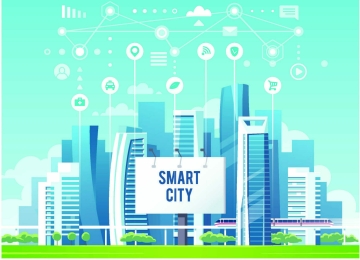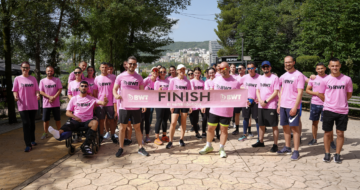What are the challenges of a Smart City project?

Lots has been undertaken, done and written about Smart City projects. What is common ground, is that there are lots of challenges to tackle when starting a Smart City project. We have listed the 8 most heard challenges.
Lots has been undertaken, done and written about Smart City projects. What is common ground, is that there are lots of challenges to tackle when starting a Smart City project. We have listed the 8 most heard challenges.
1. Making the right decisions
How can you determine the right priorities when converting concepts into concrete projects? It is important to diverge first and to give room for ideation, but in the following phase a structured approach and focus are needed.
An aligned vision will help the city or municipality to excel as a "smart and warm" municipality with a citizen-close policy. Having a clear vision in mind is essential to measure the progress and development of a (smart) city. It gives direction for all stakeholders in the ecosystem of the smart city or municipality. A well-defined vision starts from the challenges the city is facing, such as job creation, climate change, mobility related topics, etc. It is important to define ambitious long-term goals, but it should also include local short-term objectives to achieve this longer-term big audacious goal (BAG).
But the impact of choices is sometimes difficult to predict upfront. Having a clear action plan with priorities is a good start, but the objectives have to be measurable and specific. Based on available data and statistics, KPI’s (Key performance indicators) can be defined to measure the impact.
Let’s take the modal shift challenge as an example. Before starting the project and money gets burned, the specific situation and needs within the environment have to be clarified. Eg. How many people drive to work by car, what is the share of public transport, what are the bottlenecks and so on. Based on these insights, measurable objectives can be defined. In any case one should ask the question which are the criteria to identify success?
What if impact is not as foreseen? We come back to this later in this article.
2. Involving external stakeholders
To avoid a tunnel vision and to test concepts, an external ecosystem is needed to involve in the different steps of a project, from concept to development. But this requires time and focus to involve the right stakeholders in the different phases of a Smart City approach. The Quadruple Helix approach can come in as solution to guide you in this selection.
First of all, knowledge can come from academia, such as R&D, education and incubators. Based on their expertise, they can provide insights on the different challenges. Take again the example of the modal shift: a lot of research is already done on this matter. Surveys and statistics exist about the different mobility modes and the same goes for the existing knowledge about trends and technologies.
On the other hand, there are the solution providers. Most probably, they developed a solution for an existing problem or can possibly extend their portfolio with customized solutions. Collaboration between the public and private sector can accelerate innovation and this is wat we need in a Smart City.
One of the main stakeholders are the citizens. They know the pains and the gains by the daily use of the services of a city or municipality. Let’s have a look at the third challenge.
3. Citizen involvement
With citizen involvement you increase public support, the quality of the policy and you work on community building. Involving residents ensures that the policy is more in line with the practice. They have the best view on what is happening in the city: the needs that exist and the improvements that need to be done.
But how can you involve citizens in various initiatives? At what level? How do you set the right expectations? There are different levels of involvement, which goes from informing the citizen up to co-creation and even decision making. Take the example of ‘Leuven, maak het mee!’. This platform empowers the citizens of Leuven to share and vote for ideas.
Citizen involvement is also possible at a higher level and in a specific sector: an example is given by MOW, the Flemish Mobility and Public Works. Based on future scenarios people are invited to post their ideas to shape the future of mobility in Flanders.
The level of involvement is a decision to be taken by the local government. But in all cases, it is crucial to build the bridge with the citizen to increase the quality of life. To say it in business terms: the best leaders are those who know what is happening around by talking to employees and their market. Communication is key in this.
it is crucial to build the bridge with citizens to increase the quality of life
4. Availability of resources and money
In these times, resources and money become more scarce so decisions should be made wisely. As already discussed in the first challenge, a structured approach for vision development, strategy and implementation helps. It also helps to set up an action priority matrix which defines the level of impact and effort of doing a certain project. With other words, is it feasible to do it and is it worthwhile to have it?
With the COVID-19 crisis we have seen that many projects that were previously questioned are getting off the ground now. Mainly these are related to digital or remote applications such as making an appointment via an online app. Before they were not seen as essential but are now necessarily accelerated. Most probably if these projects were given a score in the priority matrix, they were in the Quick win (low hanging fruit) or Longer term projects quadrant.
One should always keep in mind the efficiency gains the solution provides. As such, the investment is worth considering if it will reduce the operational costs on the longer term.
5. Tangible solutions
The local government mostly wants to quickly adopt concrete solutions by means of pilots and projects. This gives visibility to their legislature, which is important since they only have 4 years to show their impact. That is why it is important to make the right choices in order to achieve small and large successes quickly and efficiently. Subsidies are very important in this.
As stated before, this is the right philosophy as long it is part of a long term vision. Even more, it is crucial to apply the lean approach with short delivery cycles. The faster something is brought into practice, the more agile the city or municipality becomes.
To give an extreme example: in the fight against the climate change, it is not a good idea to set-up a complete plan for 2030 and to launch a bunch of solutions at the end of this period. By that time, it will be too difficult to steer the solution into another direction and to measure the impact of the different actions taken. It is more efficient to start with a smaller scope with a shorter timeline and to continuously measure the impact. In this way, insights can be gathered after the going live of each project and revisions to the action plan can be done where necessary.
6. Data management
Local authorities are convinced of the principle "to measure is to know". However, there are still a number of challenges here. First of all, not all data is accessible. A lot of service providers but also public authorities have data on hand, but these are often not used optimally. There are for example lots of ANPR cameras in the streets for license plate recognition. They are a golden source of data and could give an answer to different type of challenges related to climate, traffic, crowd control and so on.
Of course, data privacy and security have to be guaranteed at all times. People don’t like the idea that their data is used without any consensus, unless there is a clear purpose and a "What’s in it for me?".
There is a major challenge in making data intelligent and making data accessible to citizens. And that is hard to achieve as individual city or municipality, since it requires cooperation from the different involved parties. This begins with a clear data policy clarifying the scope of the required data.
There is a major challenge in making data intelligent and making data accessible to citizens.
7. Trends & evolutions
We are living in a VUCA world (volatile, uncertain, complex and ambiguous). Everything changes fast. So keeping pace of these changes and trends in all policy domains is important for a municipality or city as well to make the right choices and invest in projects which are futureproof. But inspiration and cross-pollination is important as well. How do other authorities do this (peripheral municipalities, but also across the provinces)? How are Smart Cities evolving? Which solutions and technological applications exist today and tomorrow?
Gathering these insights on a daily or even weekly basis is a thorough job and this requires effort. As stated above there is often a shortage of resources who can spend their time dedicated to this research. A forum to share knowledge and visions might help to inspire each other. This is not only about sharing ideas and successes, but also learnings from past Smart City projects.
8. Transversal thinking
Today's choices are mainly made from a specific policy domain and not from a holistic view. Breaking down the silos and start from transversal thinking across the various policy domains is required for a "smart" total solution.
The level of integration between the different policy domains (see picture below), the infrastructure and data defines the level of the smartness of a city or municipality.
The different domains are inextricably linked to each other. For instance, waste management can have a valuable impact on environment, safety, wellbeing and city logistics. As such, specific objectives and a clear data policy should be defined across these domains.
Conclusions
Each city or municipality may experience a different order of magnitude of the challenges mentioned above. However, they have two objectives in common and that is to drive economic growth and quality of life. When the different puzzle pieces come together - the use of technology and data, the handshake between public and private organisations, and the voice of the citizens - that’s what makes a city or municipality really ‘smart’.
Do you need help with Smart City projects?
Get in touch with the TomorrowLab team.
Latest insights & stories

A Global Movement: The World Unites in a Pink Pledge for Clean and Sustainable Water
5,000 participants. 32 countries. €30,000 funds raised. And that's just the beginning.
Picture this: One step that sends ripples across the globe, transforming lives and creating waves of change. You might wonder, how can such a simple action for most of us have such a profound impact?

Sustainability and circularity in construction
Join us in transforming the future of construction, creating buildings that not only stand the test of time but also contribute to a healthier planet!

RainTunes: Shower scenarios for the soul
Light, hearing, smell, and touch: Together with experts, we have developed sensuous scenarios that turn showering into an individual experience. Whether you want to prepare for the day ahead or relax after working out. Whether you want to refresh after a day’s work or unwind at the end of the evening: RainTunes surprises with multisensory experiences.*
*Currently available only in Germany and Austria.